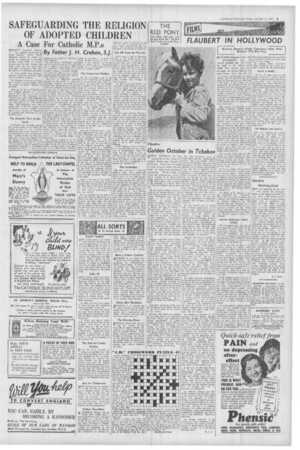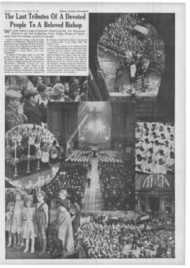Page 3, 14th October 1949
Page 3

Report an error
Noticed an error on this page?If you've noticed an error in this article please click here to report it.
Tags
Share
Related articles
Pictures In Church : 458
Priest At Work Flaubert: A Biography, By Philip Spencer...
Biography
Ill Arterhouse Chronicle41 By Lionel Grady
Television
FLAUBERT IN HOLLYWOOD
Madame Bovary—Under Capricorn—Date With Destiny—The Red Pony FLAUBERT belonged to that not inconsiderable band of famous novelists who also tried
his hand at the theatre—and failed. Now, seventy years after
his death, the cinema finds in his most famous work the stuff of visual drama and M.G.M. gets their famous lion to announce the presence of Madame Bovary (Emente) in our midst. I will confess that I approached the viewing of this experiment with the utmost misgiving for, graphically as Flaubert paints the provincial France of his day, it is only a setting for Emma Bovary 's defections as a wife and a mother explained in unglamorous detail and altogether not the stuff that Hollywood handles well or that the censors easily pass.
This armour of 'misgiving is an excellent protection against disappointment. Go expecting the worst and you will be only too glad, if you are honest, to acknowledge that you were unduly pessimistic. So it was on this occasion. For while Jennifer Jones as Emma is always too exquisitely turned out; while Director Vincente Minnelli has not the courage to show her bedraggled, careless of how she looked (when her first lover deserted her), or even the sordid house of the foster-mother with whom she farmed out her unfortunate child, still the germ of the book is there. By some means (and no one will dare accuse Hollywood of cruelty to children), little Dawn Kinney, who plays the part of Bcrthc, yells blue murder every time Emma comes near her.
Also on the credit side are the casting of Louis Jourdan as Rudolphe Boulanger and the final scene between himself and Emma when she makes that pitiful attempt to rekindle the old fire so that he will pay her debts.
Of the rich gallery of characters which Flaubert gives us in the novel, only shadows appear. That reliable character actor, Gene Lockhart, gets no chance at all to exploit the always magnificent old humbug, Homais, the pharmacien—and, for some reason utterly unknown, the whole episode of the clubfoot operation is turned upside down. Dr. Bovary refuses to perform it.
Van Heflin as Dr. Bovary, is far too urbanised and " refeened." Those who have read the book will remember that Flaubert made a plea for Emma's behaviour on the grounds that her husband was a coarse-grained fellow with no drawing-room manners—but Mr. Heflin doesn't spit once. James Mason, in a wonderful period make-up as Flaubert himself, appears briefly in a prologue.
INGRID BERGMAN DOWN UNDER
That ten-minute take you saw in Rope goes into action under Alfred Hitchcock's direction again in the latest Ingrid Bergman film Under Capricorn (Weems's) and effective it is in testing an actor's memory and technique and in affording most welcome relief from the eternal jerky machinery of the flashback.
Just to give you an idea of the tortuous journey by which a film plot comes to life, I quote from the programme: " Screen play by James Bridie. Adaptation by Hume Cronyn. Based on the play by John Colton and Margaret Linden. From the novel by Helen Simpson." Not having read the book or seen the play I came to this one with a fresh mind and enjoyed it, in spite of having to watch Cecil Parker in a too long sequence sitting in a bath tub at Sydney's government house in the year 1831.
Unlike Madame Bovary, this is a story of marital fidelity—and of a love that is strong enough to weather all winds. And that in spite of the girl being " Lady Hattie" and the man being her father's groom. (Ingrid Bergman and Joseph Cotten.) The third man, Michael Wilding. also strikes a new note and after doing a spot of reconstruction in the lives of the two, retires gracefully from the scene, his heart bruised, if not broken.
It is in the polished acting of these three, and the unselfish acting of Margaret Leighton as a sort of female lago, that this long film of Australia's pioneering days (all in Technicolor) succeeds. Ingrid Bergman, always mentally on top of any part she plays, gives us a piteous glimpse of a woman who is in the grip of dipsomania, almost in the process of disintegration. It is she
who is entrusted with the ten-minute monologue on which the v.hole hinge of the story hangs.
In making Under Capricorn. Alfred Hitchcock has given us a fresh, original bit of entertainment.
MANY A WORD ..
" If ever I come back to this world it will be as a horse." Words spoken in jest by James Gleason as a race track " fan " and heard by his yoking niece (Terry Moore) in a cheerful bit of nonsense expertly put over in Date With Destiny (I ONDON PAVILION). Not long after Uncle Willie (his name) drops dead and the grief-stricken girl who, true to form, hangs about the stables, suddenly finds in a horse there a distinct resemblance! What with her eccentric aunt leaving her all her money, angry relatives contesting the will on the grounds of insanity, and a young professor who is making a clinical study of her behaviour, the plot develops hilariously with a racing climax in which the second Uncle Willie wins the Kentucky Durby." Glenn Ford, graduating from heavier roles, enters with zest into the spirit of this brief and bright film.
NO SMILES FOR MYRNA Why. one wonders, does Myrna Loy, in the Red Pony (PLizs), go through the whole of the latest boy-plus-pet story with a face that is so faultily faultless, splendidly null, not to mention icily regular? As a native of Montana (as we have been told so often) she ought to look more cheerful on the ranch. She even moves about her work with a dilettantism that is quite unnerving and she has the queerest notion of bedmaking. The boy with the pony is Peter Miles—a delightful child and at the other end of the age group is Louis Calhern as grandpa. An absorbing if rather sombre picture of farm life with Robert Mitchum as a decent and monosyllabic farm hand. The story is by John Steinbeck.
blog comments powered by Disqus











